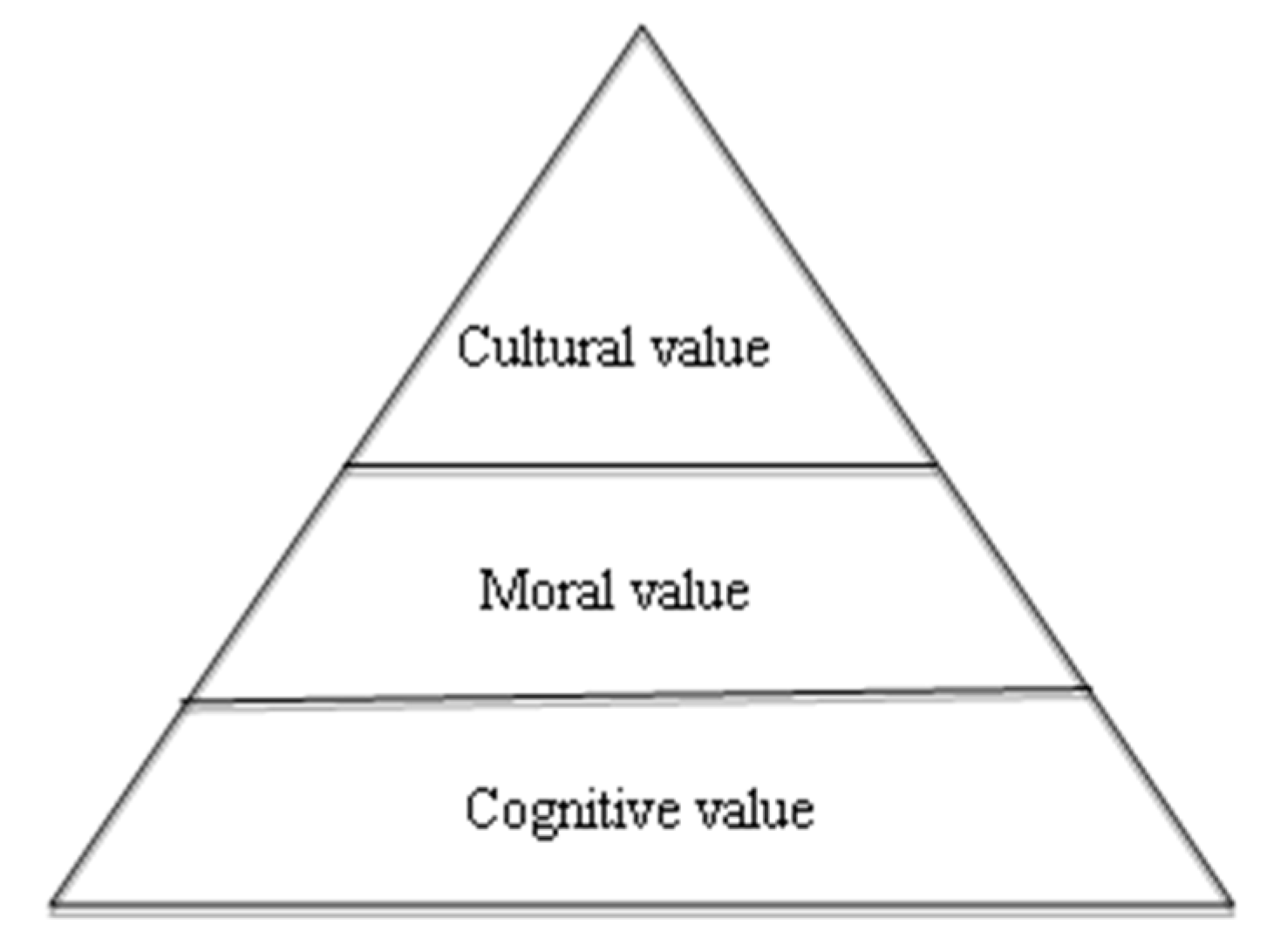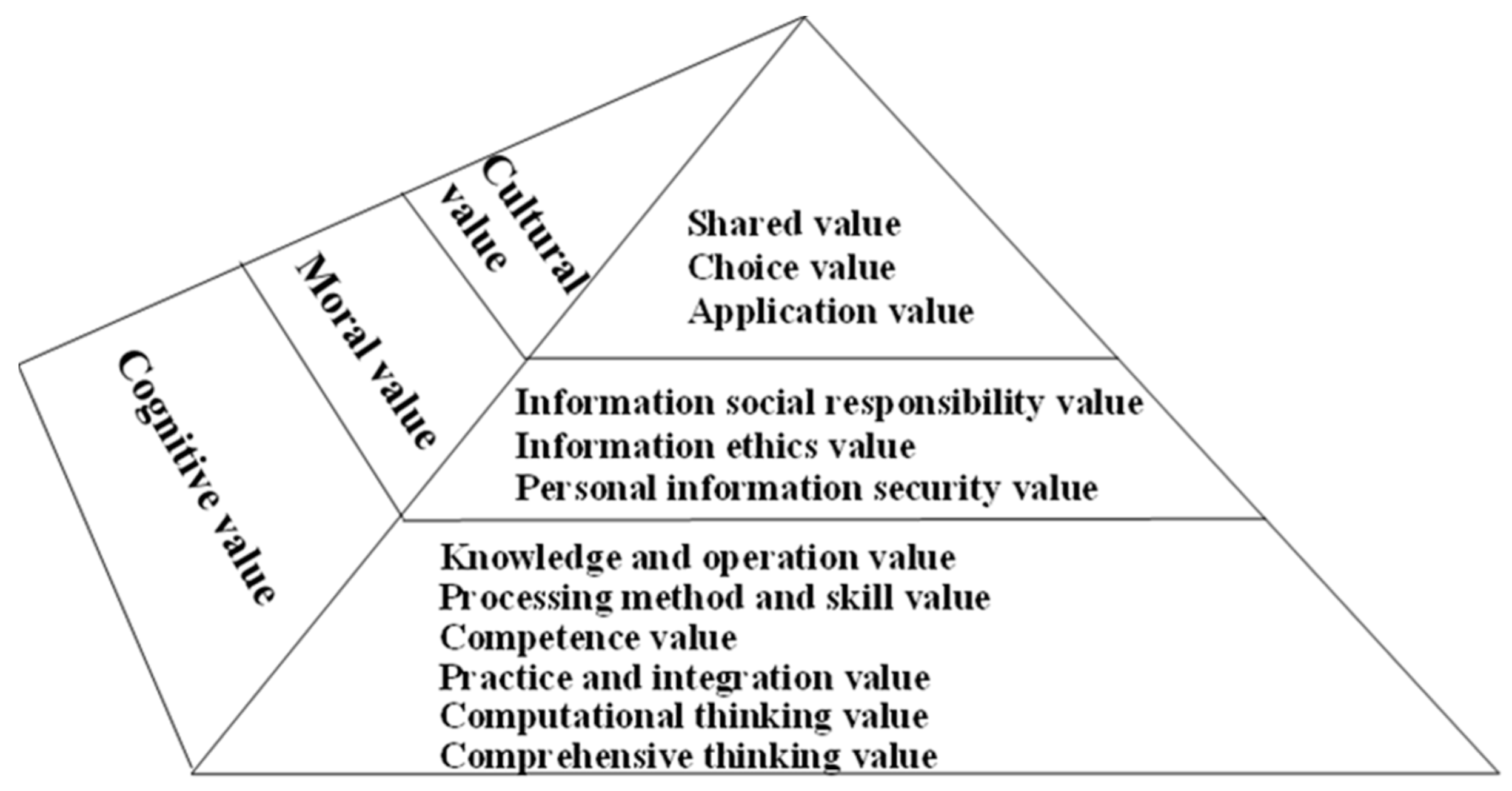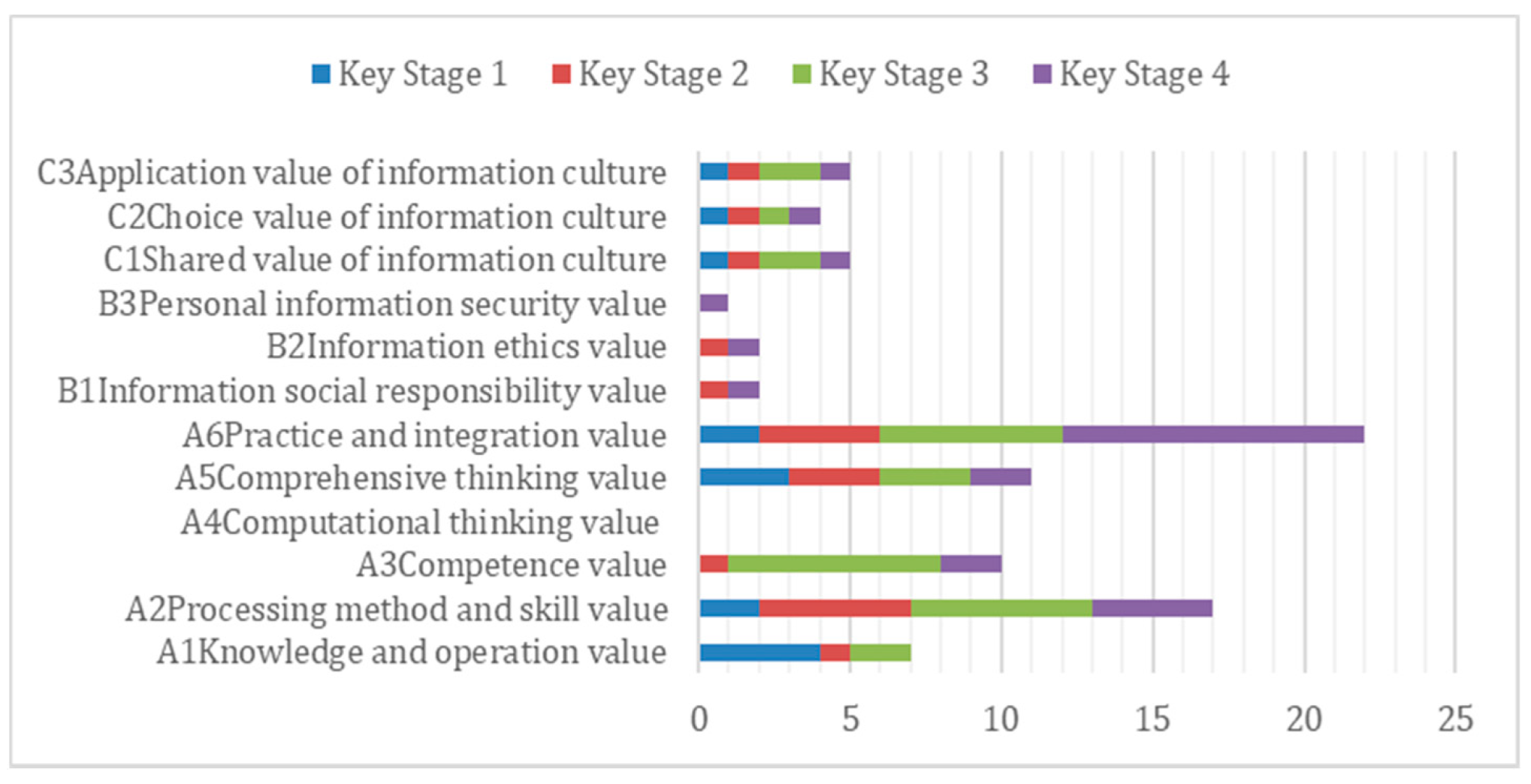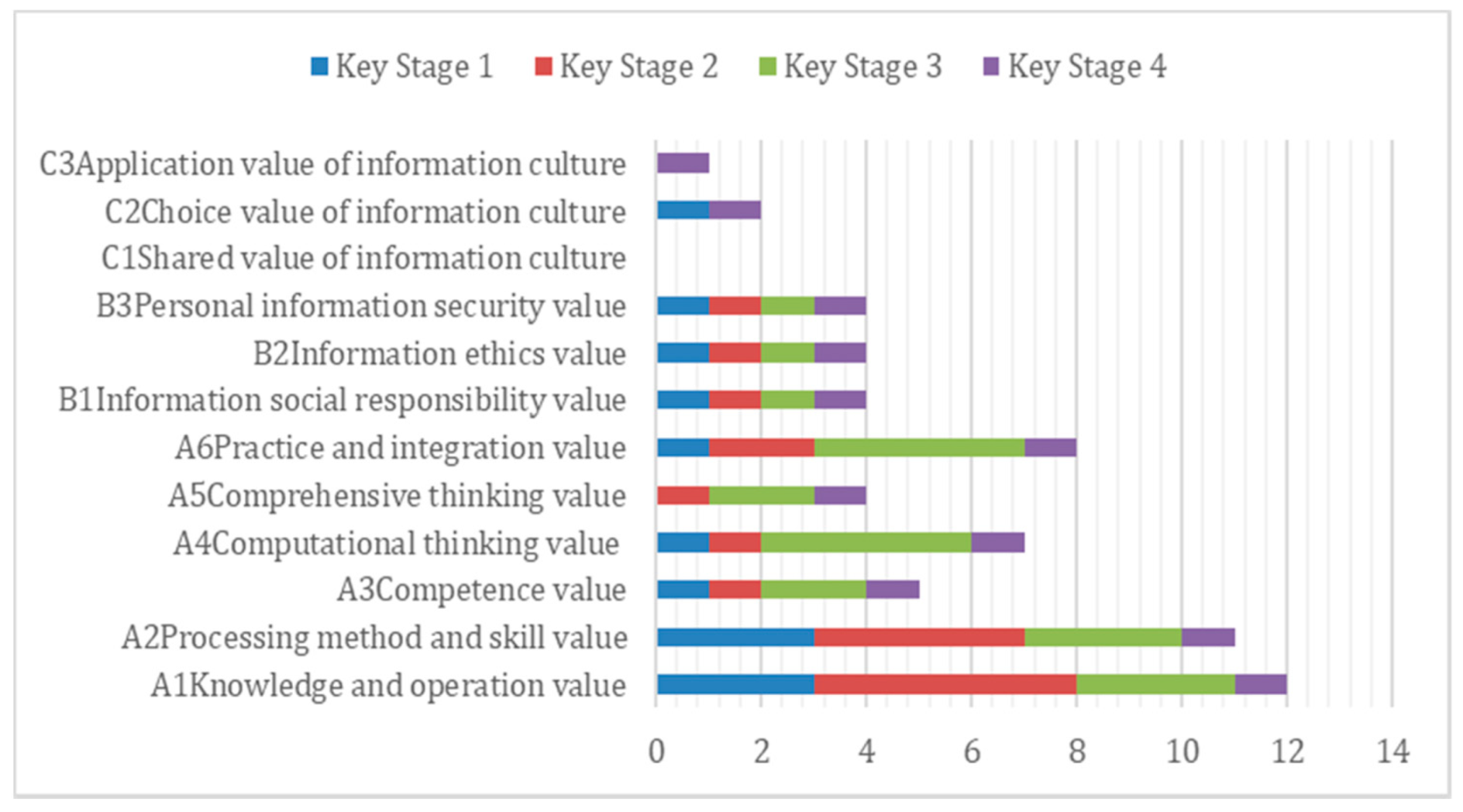Reflection on Value and Function of Information Technology Curriculum from the Reform of the British ICT Curriculum
Abstract
1. Introduction
2. Background
2.1. ICT Curriculum Standards’ Background
2.2. Computing Curriculum Standards’ Background
3. Theoretical Framework
3.1. Values
3.2. Curriculum Values
3.3. Curriculum Value Orientations
3.4. Values in Information Technology Curriculum
3.4.1. Characteristics of Values in Information Technology Curriculum
3.4.2. Levels of Values in Information Technology Curriculum
3.4.3. Construction of Information Technology Curriculum Value System
4. Methodology
4.1. Content Analysis Method
4.1.1. Select the Content Analysis Framework
4.1.2. Trial the Content Analysis Framework
4.1.3. Determine the Content Analysis Framework
4.2. Comparative Research Method
5. Results
5.1. Comparison of Aims and Values under the Reform of Curriculum Standards
5.2. Comparison Results of Specific Value Performances
5.2.1. Comparison Results and Analysis of Specific Value Performances in the ICT and Computing Curriculum Content in Different Key Stages
5.2.2. Comparison Results and Analysis of Specific Value Performances in the ICT and Computing Curriculum Content in the Same Key Stage
6. Discussion and Conclusions
Author Contributions
Funding
Institutional Review Board Statement
Informed Consent Statement
Data Availability Statement
Conflicts of Interest
References
- OECD. Education at a Glance 2015: OECD Indicators; OECD Publishing: Paris, France, 2015. [Google Scholar]
- The Select Committee on Digital Skills. Make or Break: The UK’s Digital Future; The House of Lords Publishing: London, UK, 2015. [Google Scholar]
- Liu, X.Y. Research on Value of Information Technology Curriculum. Doctoral Dissertation, Northeast Normal University, Changchun, China, 2010. [Google Scholar]
- Department for Education. Opportunity for All: Strong Schools with Great Teachers for Your Child; HH Associates Ltd.: London, UK, 2022. [Google Scholar]
- Brown, N.C.C.; Sentance, S.; Crick, T.; Humphreys, S. Restart: The Resurgence of Computer Science in UK Schools. ACM Trans. Comput. Educ. 2014, 14, 1–22. [Google Scholar] [CrossRef]
- Webb, M.; Davis, N.; Bell, T.; Katz, Y.; Reynolds, N.; Chambers, D.P.; Sysło, M.M. Computer Science in K-12 School Curricula of the 2lst Century: Why, What and When? Educ. Inf. Technol. 2017, 22, 445–468. [Google Scholar] [CrossRef]
- Gove, M. Michael Gove Speech at the BETT Show 2012. Available online: https://www.gov.uk/government/speeches/michael-gove-speech-at-the-bett-show-2012 (accessed on 5 May 2022).
- Brown, N.C.C.; Kölling, M.; Crick, T.; Jones, S.P.; Humphreys, S.; Sentance, S. Bringing Computer Science Back into Schools: Lessons from the UK. In Proceedings of the SIGCSE 2013—44th ACM Technical Symposium on Computer Science Education, Denver, CO, USA, 6–9 March 2013; pp. 269–274. [Google Scholar]
- Livingstone, I.; Hope, A. Next Gen: Transforming the UK in to the World’s Leading Talent Hub for the Video Games and Visual Effects Industries; Nesta: London, UK, 2011. [Google Scholar]
- Department for Education and Skills. ICT across the Curriculum (Management Guide); DfES Publications: London, UK, 2004. [Google Scholar]
- Jones, S.P. Computing at School: The State of the Nation; UK Computing Research Committee: London, UK, 2010; pp. 1–17. [Google Scholar]
- Schulte, C.; Hornung, M.; Sentence, S.; Dagiene, V.; Jevsikova, T.; Thota, N.; Eckerdal, A.; Peters, A.K. Computer Science at School/CS Teacher Education—Koli Working-Group Report on CS at School. In Proceedings of the 12th Koli Calling International Conference on Computing Education Research, Tahko, Finland, 15–18 November 2012; pp. 29–38. [Google Scholar]
- Ofsted. Research Review Series: Computing. Available online: https://www.gov.uk/government/publications/research-review-series-computing/research-review-series-computing (accessed on 16 May 2022).
- Department for Education. The National Curriculum in England: Framework Document. Available online: https://www.gov.uk/government/publications/national-curriculum-in-england-framework-for-key-stages-1-to-4/the-national-curriculum-in-england-framework-for-key-stages-1-to-4 (accessed on 2 June 2022).
- Department for Education. National Curriculum in England: Computing Programmes of Study. Available online: https://www.gov.uk/government/publications/national-curriculum-in-england-computing-programmes-of-study (accessed on 11 June 2022).
- Computing at School. Computing in the National Curriculum—A Guide for Secondary Teachers. Available online: https://www.computingatschool.org.uk/resource-library/2014/september/computing-in-the-national-curriculum-a-guide-for-secondary-teachers (accessed on 5 June 2021).
- Weber, M. The Protest Ethic and the Spirit of Capitalism (Translated by Talcott Persons); Routledge: London, UK; New York, NY, USA, 1958. [Google Scholar]
- Oeschger, T.P.; Makarova, E.; Anna, K.D. Values in the School Curriculum from Teachers’ Perspective: A Mixed-Methods Study. Int. J. Educ. Res. Open 2022, 3, 100190. [Google Scholar] [CrossRef]
- Schwartz, S.H. Are There Universal Aspects in the Structure and Contents of Human Values ? J. Soc. Issues 1994, 50, 19–45. [Google Scholar] [CrossRef]
- Inglehart, R.; Welzel, C. Modernization, Cultural Change, and Democracy: The Human Development Sequence; Cambridge University Press: Cambridge, UK, 2005. [Google Scholar]
- Inglehart, R. The Silent Revolution: Changing Values and Political Styles among Western Publics; Princeton University Press: Princeton, NJ, USA, 1977. [Google Scholar]
- Halstead, J.M.; Taylor, M.J.; Taylor, M.J. Learning and Teaching about Values: A Review of Recent Research. Camb. J. Educ. 2000, 30, 169–202. [Google Scholar] [CrossRef]
- Gillies, D. A Curriculum for Excellence: A Question of Values. Scott. Educ. Rev. 2006, 38, 25–36. [Google Scholar] [CrossRef]
- Dewey, J. Democracy and Education 1916; Macmillan: New York, NY, USA, 2004. [Google Scholar]
- Eisner, E. Curriculum Ideologies. In Handbook of Research on Curriculum; Macmillan: New York, NY, USA, 1992; pp. 47–83. [Google Scholar]
- Ennis, C.D. Curriculum Theory as Practiced: Case Studies of Operationalized Value Orientations. J. Teach. Phys. Educ. 1992, 11, 358–375. [Google Scholar] [CrossRef]
- Ennis, C.D.; Chen, A. Teachers’ Value Orientations in Urban and Rural School Settings. Res. Q. Exerc. Sport 1995, 66, 41–50. [Google Scholar] [CrossRef]
- Ennis, C.D.; Chen, A.; Ross, J. The Role of Value Orientations in Curricular Decision Making: A Rationale for Teachers’ Goals and Expectations. Res. Q. Exerc. Sport 1992, 63, 38–47. [Google Scholar] [CrossRef][Green Version]
- Pratt, D.D. Good Teaching: One Size Fits All? Jossey-Bass: San Francisco, CA, USA, 2002. [Google Scholar]
- Gillespie, L.B. Exploring the “how” and “Why” of Value Orientations in Physical Education Teacher Education. Aust. J. Teach. Educ. 2011, 36, 22–38. [Google Scholar] [CrossRef]
- Ennis, C.D.; Mueller, L.K.; Hooper, L.M. The Influence of Teacher Value Orientations on Curriculum Planning within the Parameters of a Theoretical Framework. Res. Q. Exerc. Sport 1990, 61, 360–368. [Google Scholar] [CrossRef] [PubMed]
- Nespor, J.K. The Role of Beliefs in the Practice of Teaching. J. Curric. Stud. 1987, 19, 317–328. [Google Scholar] [CrossRef]
- Li, D.S. Value Theory: A Research into Subjectivity; Springer: Heidelberg, Germany, 2014. [Google Scholar]
- Gouëdard, P.; Pont, B.; Hyttinen, S.; Huang, P. Curriculum Reform: A Literature Review to Support Effective Implementation; OECD Education Working Papers, No. 239; OECD Publishing: Paris, France, 2020. [Google Scholar]
- Maslow, A.H. A Theory of Human Motivation. Psychol. Rev. 1943, 50, 370–396. [Google Scholar] [CrossRef]
- Long, Q. The Research on the Educational Value of Geography Disciplinary and Its Teaching Implementation Strategy. Doctoral Dissertation, Central China Normal University, Wuhan, China, 2017. [Google Scholar]
- Ennis, C.D.; Chen, A. Domain specifications and content representativeness of the revised value orientation inventory. Res. Q. Exerc. Sport 1993, 64, 436–446. [Google Scholar] [CrossRef]
- Ennis, C.D.; Zhu, W. Value orientations: A description of teachers’ goals for student learning. Res. Q. Exerc. Sport 1991, 62, 33–40. [Google Scholar] [CrossRef]
- Voogt, J.; Pelgrum, H. ICT and curriculum change. Hum. Technol. Interdiscip. J. Hum. ICT Environ. 2005, 1, 157–175. [Google Scholar] [CrossRef]
- Wohl, B.S.; Beck, S.; Blair, L. The future of the computing curriculum: How the computing curriculum instills values and subjectivity in young people. Int. J. Comput. Sci. Educ. Sch. 2017, 1, 21–29. [Google Scholar] [CrossRef][Green Version]
- The Royal Society. Shut Down or Restart? The Way Forward for Computing in UK Schools. Available online: https://royalsociety.org/~/media/education/computing-in-schools/2012-01-12-computing-in-schools.pdf (accessed on 13 June 2022).
- Gagne, R.M. Conditions of Learning; CBS College Publishing: New York, NY, USA, 1985. [Google Scholar]
- Fluck, A.; Webb, M.; Cox, M.; Angeli, C.; Malyn-Smith, J.; Voogt, J.; Zagami, J. Arguing for Computer Science in the School Curriculum. J. Educ. Technol. Soc. 2016, 19, 38–46. [Google Scholar]
- Bell, T.; Alexander, J.; Freeman, I.; Grimley, M. Computer Science Unplugged: School Students Doing Real Computing without Computers. N. Z. J. Appl. Comput. Inf. Technol. 2009, 13, 20–29. [Google Scholar]
- Moller, F.; Crick, T. A University-Based Model for Supporting Computer Science Curriculum Reform. J. Comput. Educ. 2018, 5, 415–434. [Google Scholar] [CrossRef]
- Sentance, S.; Dorling, M.; McNicol, A. Computer Science in Secondary Schools in the UK: Ways to Empower Teachers. In Informatics in Schools: Sustainable Informatics Education for Pupils of All Ages; Diethelm, I., Mittermeir, R.T., Eds.; Springer: Berlin/Heidelberg, Germany, 2013; pp. 15–30. [Google Scholar]
- Smith, N.; Allsop, Y.; Caldwell, H.; Hill, D.; Csizmadia, A.P.; Dimitriadi, Y. Master Teachers in Computing: What Have We Achieved? In Proceedings of the Workshop in Primary and Secondary Computing Education, London, UK, 9–11 November 2015. [Google Scholar]
- Rich, P.J.; Browning, S.F.; Perkins, M.K.; Shoop, T.; Yoshikawa, E.; Belikov, O.M. Coding in K-8: International Trends in Teaching Elementary/Primary Computing. TechTrends 2019, 63, 311–329. [Google Scholar] [CrossRef]
- Larke, L.R. Agentic Neglect: Teachers as Gatekeepers of England’s National Computing Curriculum. Br. J. Educ. Technol. 2019, 50, 1137–1150. [Google Scholar] [CrossRef]
- Black, J.; Brodie, J.; Curzon, P.; Myketiak, C.; McOwan, P.W.; Meagher, L.R. Making Computing Interesting to School Students: Teachers’ Perspectives. In Proceedings of the 18th ACM Conference on Innovation and Technology in Computer Science Education (ITiCSE’13), Canterbury, UK, 1–3 July 2013; pp. 255–260. [Google Scholar]




| First-Level Index | Second-Level Index | Code Basis |
|---|---|---|
| A Cognitive value | A1 Knowledge and operation value | Knowledge and operation of information technology discipline |
| A2 Processing method and skill value | Processing method and skill of information technology discipline | |
| A3 Competence value | Competence in Information technology discipline | |
| A4 Computational thinking value | Computational thinking mode of information technology discipline | |
| A5 Comprehensive thinking value | Comprehensive thinking mode of information technology discipline | |
| A6 Practice and integration value | Integration approach and attitude to information technology discipline | |
| B Moral value | B1 Information social responsibility value | Information technology humanistic care for society |
| B2 Information ethics value | Information technology humanistic care for others | |
| B3 Personal information security value | Information technology humanistic care for individuals | |
| C Cultural value | C1 Shared value of information culture | The influence of student information literacy on cultural sharing and blending |
| C2 Choice value of information culture | Students criticize and choose information culture in order to adapt to the knowledge society of information technology | |
| C3 Application value of information culture | Students innovate, understand and develop information culture |
| ICT Standard | Computing Standard | |
|---|---|---|
| Specific value performances of learning objectives |
|
|
| Specific value performances of curriculum objectives |
|
|
| Key Stages | Curriculums | Cognitive Values | Moral Values | Cultural Values |
|---|---|---|---|---|
| Key Stage 1 | ICT curriculum | × | × | |
| Computing curriculum | × | × | × | |
| Key Stage 2 | ICT curriculum | × | × | × |
| Computing curriculum | × | × | ||
| Key Stage 3 | ICT curriculum | × | × | |
| Computing curriculum | × | × | ||
| Key Stage 4 | ICT curriculum | × | × | × |
| Computing curriculum | × | × | × |
Disclaimer/Publisher’s Note: The statements, opinions and data contained in all publications are solely those of the individual author(s) and contributor(s) and not of MDPI and/or the editor(s). MDPI and/or the editor(s) disclaim responsibility for any injury to people or property resulting from any ideas, methods, instructions or products referred to in the content. |
© 2022 by the authors. Licensee MDPI, Basel, Switzerland. This article is an open access article distributed under the terms and conditions of the Creative Commons Attribution (CC BY) license (https://creativecommons.org/licenses/by/4.0/).
Share and Cite
Li, X.; Zhang, J.; van Braak, J. Reflection on Value and Function of Information Technology Curriculum from the Reform of the British ICT Curriculum. Educ. Sci. 2023, 13, 7. https://doi.org/10.3390/educsci13010007
Li X, Zhang J, van Braak J. Reflection on Value and Function of Information Technology Curriculum from the Reform of the British ICT Curriculum. Education Sciences. 2023; 13(1):7. https://doi.org/10.3390/educsci13010007
Chicago/Turabian StyleLi, Xinlei, Jinbao Zhang, and Johan van Braak. 2023. "Reflection on Value and Function of Information Technology Curriculum from the Reform of the British ICT Curriculum" Education Sciences 13, no. 1: 7. https://doi.org/10.3390/educsci13010007
APA StyleLi, X., Zhang, J., & van Braak, J. (2023). Reflection on Value and Function of Information Technology Curriculum from the Reform of the British ICT Curriculum. Education Sciences, 13(1), 7. https://doi.org/10.3390/educsci13010007






